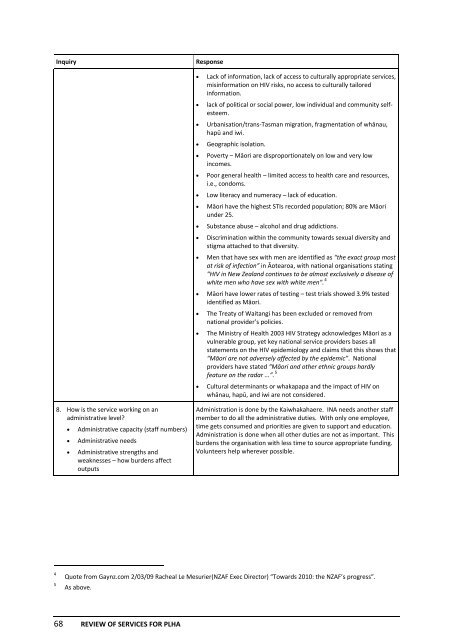InquiryResponseLack <strong>of</strong> <strong>in</strong><strong>for</strong>mation, lack <strong>of</strong> access to culturally appropriate <strong>services</strong>,mis<strong>in</strong><strong>for</strong>mation on <strong>HIV</strong> risks, no access to culturally tailored<strong>in</strong><strong>for</strong>mation.lack <strong>of</strong> political or social power, low <strong>in</strong>dividual and community selfesteem.Urbanisation/trans‐Tasman migration, fragmentation <strong>of</strong> whānau,hapū and iwi.Geographic isolation.Poverty – Māori are disproportionately on low and very low<strong>in</strong>comes.Poor general health – limited access to health care and resources,i.e., condoms.Low literacy and numeracy – lack <strong>of</strong> education.Māori have the highest STIs recorded population; 80% are Māoriunder 25.Substance abuse – alcohol and drug addictions.Discrim<strong>in</strong>ation <strong>with</strong><strong>in</strong> the community towards sexual diversity andstigma attached to that diversity.Men that have sex <strong>with</strong> men are identified as “the exact group mostat risk <strong>of</strong> <strong>in</strong>fection” <strong>in</strong> Āotearoa, <strong>with</strong> national organisations stat<strong>in</strong>g“<strong>HIV</strong> <strong>in</strong> <strong>New</strong> <strong>Zealand</strong> cont<strong>in</strong>ues to be almost exclusively a disease <strong>of</strong>white men who have sex <strong>with</strong> white men”. 4Māori have lower rates <strong>of</strong> test<strong>in</strong>g – test trials showed 3.9% testedidentified as Māori.The Treaty <strong>of</strong> Waitangi has been excluded or removed fromnational provider’s policies.The M<strong>in</strong>istry <strong>of</strong> Health 2003 <strong>HIV</strong> Strategy acknowledges Māori as avulnerable group, yet key national service providers bases allstatements on the <strong>HIV</strong> epidemiology and claims that this shows that“Māori are not adversely affected by the epidemic”. Nationalproviders have stated “Māori and other ethnic groups hardlyfeature on the radar ...”. 5Cultural determ<strong>in</strong>ants or whakapapa and the impact <strong>of</strong> <strong>HIV</strong> onwhānau, hapū, and iwi are not considered.8. How is the service work<strong>in</strong>g on anadm<strong>in</strong>istrative level?Adm<strong>in</strong>istrative capacity (staff numbers)Adm<strong>in</strong>istrative needsAdm<strong>in</strong>istrative strengths andweaknesses – how burdens affectoutputsAdm<strong>in</strong>istration is done by the Kaiwhakahaere. INA needs another staffmember to do all the adm<strong>in</strong>istrative duties. With only one employee,time gets consumed and priorities are given to support and education.Adm<strong>in</strong>istration is done when all other duties are not as important. Thisburdens the organisation <strong>with</strong> less time to source appropriate fund<strong>in</strong>g.Volunteers help wherever possible.45Quote from Gaynz.com 2/03/09 Racheal Le Mesurier(NZAF Exec Director) “Towards 2010: the NZAF’s progress”.As above.68 REVIEW OF SERVICES FOR PLHA
Inquiry9. How is impact, effectiveness and valueassessed, and what have those assessments<strong>in</strong>dicated to date?Criteria employedFrequency and modes <strong>of</strong> assessmentsEvidence <strong>of</strong> data <strong>for</strong> policy10. Are there any gaps <strong>in</strong> service coverage thatneed future <strong>in</strong>vestment?11. Are there plans <strong>for</strong> service development orevolution?ResponseOutcomes are measured by short term, mid term and long term goals.Each programme that INA adm<strong>in</strong>isters <strong>in</strong>cluded a client evaluation andfeedback <strong>for</strong>m. When education sem<strong>in</strong>ars are conducted whether <strong>in</strong>partnership <strong>with</strong> other organisations or alone, INA is able to capture<strong>in</strong><strong>for</strong>mation relevant to results and per<strong>for</strong>mance, this is then collatedand analysed <strong>for</strong> evidential reasons and fund<strong>in</strong>g. This data is thenreported via m<strong>in</strong>utes, reports and announcements.INA operates by donations and grants <strong>with</strong> $75,000 received <strong>in</strong> our firstyear <strong>of</strong> operation. However, the follow<strong>in</strong>g year, showed a significantdecl<strong>in</strong>e <strong>in</strong> fund<strong>in</strong>g availability <strong>for</strong> our <strong>services</strong>. Issues fac<strong>in</strong>g fund<strong>in</strong>g <strong>for</strong>INA <strong>in</strong>clude; a small pool <strong>of</strong> fund<strong>in</strong>g available <strong>for</strong> <strong>HIV</strong>, other groupscompet<strong>in</strong>g <strong>for</strong> same pool <strong>of</strong> fund<strong>in</strong>g, and the perceived ‘newness’ <strong>of</strong>our organisation. When speak<strong>in</strong>g to funders, they appreciate the need<strong>for</strong> the service, but also voice concerns about lack <strong>of</strong> support fromlarger <strong>services</strong> that hold government contracts and MOH support.The identified gaps are the provision <strong>of</strong> culturally approved andappropriate <strong>services</strong> to Māori, <strong>in</strong>digenous and Pacific <strong>people</strong>s. Withemphasis on; Māori <strong>for</strong> Māori (PI <strong>for</strong> PI) education and awareness on<strong>HIV</strong> to the community – whānau, hapū and iwi.There are non‐Māori specific <strong>services</strong> available to PLWHA; however INArecognised a gap <strong>for</strong> Māori <strong>for</strong> Māori support, whānau support, bybe<strong>in</strong>g a member <strong>of</strong> the non‐māori specific <strong>services</strong>. Regardless <strong>of</strong>where and when, the māori gravitated towards each other and grew <strong>in</strong>numbers, <strong>with</strong> the question <strong>of</strong> “Why don’t we have a Māori AIDSFoundation?”. 6 This question was answered by Māori; women, men,Takatāpui/MSM, transgender, PLWHA, kaumātua, whānau, hapū andiwi – that the time has come to have a Māori AIDS Foundation. Hencethe registration <strong>of</strong> INA (Māori, <strong>in</strong>digenous and <strong>HIV</strong>/AIDS) Foundation.INA is the gap and the need <strong>for</strong> future <strong>in</strong>vestment.INA has a comprehensive bus<strong>in</strong>ess plan highlight<strong>in</strong>g the capacitybuild<strong>in</strong>g and development <strong>of</strong> the <strong>services</strong>, <strong>in</strong>clud<strong>in</strong>g:cont<strong>in</strong>ued tra<strong>in</strong><strong>in</strong>g <strong>of</strong> PLWHA to be educators and advocates<strong>HIV</strong> campaigns nationally <strong>for</strong> whānau, hapū and iwi us<strong>in</strong>gmultimedia resources, and travell<strong>in</strong>g road showresearch projectsohu mahi – development <strong>of</strong> key PLWHA graduates <strong>of</strong> previouswānanga to be satellite <strong>services</strong> throughout <strong>New</strong> <strong>Zealand</strong>; capacitybuild<strong>in</strong>gdevelop communications strategy, to reach rural and remote areas,as well as urban. Incorporate Pacific Island AIDS ambassadors toeducate their <strong>New</strong> <strong>Zealand</strong> resident Pacific <strong>people</strong>ssource rapid test<strong>in</strong>g, and provide voluntary test<strong>in</strong>g and counsell<strong>in</strong>gemploy a whānau support coord<strong>in</strong>ator to liaison and refer to other<strong>services</strong>, a Communications coord<strong>in</strong>ator, an education coord<strong>in</strong>ator,event coord<strong>in</strong>ator and two <strong>HIV</strong> health promotersemploy a further mental health pr<strong>of</strong>essional, <strong>HIV</strong> nurse specialist,adm<strong>in</strong>istration team <strong>of</strong> three, and a research project manager.62005 Pan Pacific AIDS Conference, Māori Caucus meet<strong>in</strong>g.REVIEW OF SERVICES FOR PLHA 69
















